The best TVs that 2025 has to offer each provide truly exceptional viewing experiences. And in this best-of list we've rounded up all the very best TVs, as reviewed and rated, from QD-OLED and OLED to QLED or Mini LED – you name it!
We've got a whole host of other TV features on T3 – from the best OLED TVs if that's the specific tech you're seeking, or the best TVs under £1000 if your budget isn't as mammoth as some of the very best sets demand – so be sure to navigate around to find the most suitable option for you. Because this TVs best-buy page is exactly that: the best-of-the-best tellies you can buy, meaning these options are typically (although not always) more expensive.
These days 4K resolution, or Ultra-HD as it's sometimes known, is the going standard, so that's our starting point for these TVs. But, where relevant, this guide will also feature next-gen 8K TVs in the mix. So what TV should you buy if you want the best? Here are our top 10 picks, considering the very latest models and also including some last-gen models for a sensible balance of features to price ratio.
T3 Top 3
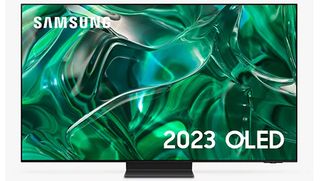
Best TV overall
The Samsung S95C is the Korean giant's QD-OLED panel type found high the company's range, delivering stunning punchy colours and coming fairly priced too. It won Best TV of the 2023 T3 Awards, marking it out as a clear winner – it can compete with OLED for black levels, but QLED for brightness levels, so it's the best of both worlds.
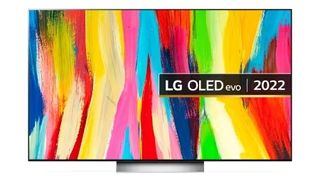
Best value TV
Not the latest LG panel (that goes to the newer C3 OLED), this older-gen panel is still a star buy. It's not cheap, per se, but it's still markedly good value – and on a spec basis it's barely any different to the model that's succeeded it. If you're after a super OLED panel that's more affordable than most that doesn't compromise then this is the pick.
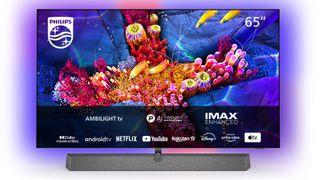
Best sounding TV
This superb TV marries picture quality with Ambilight – which spills light in real-time onto surrounding surfaces – and a superb Bowers & Wilkins soundsystem. It's that soundbar that really sets this TV alight, making it a more unique proposition that's beautifully designed. And, yes, there's the bigger OLED 987, but that'll be too massive for most.
The best TVs we recommend in 2025
Best overall

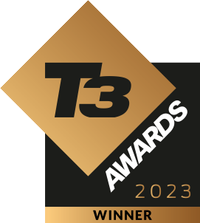
Specifications
Reasons to buy
Reasons to avoid
Even though Samsung doesn't position its 2023 QD-OLED telly (what's that? here's an explainer) as the very best it offers (that's for the Mini-LED QN95C), we think it's a stunning balance that, as said in our S95C review, "represents remarkable value for money, with awesome picture quality, a comprehensive smart system, and extensive gaming features".
Sounds like the S95C has it all then? The only real criticism is that the sound could be better, but you can always buy one of the best soundbars for Samsung TVs to help solve that. Oh, and Samsung simply refuses to support Dolby Vision for its HDR content, instead backing HDR10+ as its choice, but that's a minor misgiving in the order of things. There's also the older Samsung S95B, which is the 2022 model and has a more reflective screen, but it's an even better price and also worthy of considering.
Want to know the full ins and outs about this stunning QD-OLED TV? Read our full Samsung S95C review for the bigger picture
Best value
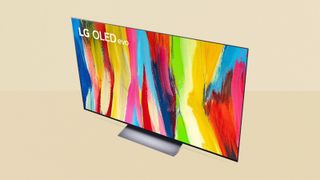
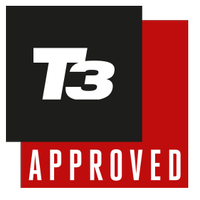
Specifications
Reasons to buy
Reasons to avoid
This is the TV that keeps on giving, because not only is it a high-flier in T3's best OLED TVs category, it's an obvious candidate for this best TVs list too. The reason is simple: in our LG OLED C2 review we said that this is "the best OLED TV for most people", delivering great picture quality at a great price point.
Why not the step-up LG G2 in this position? Because that pricier OLED panel, while brighter and therefore more accomplished, is wall-mount only out of the box and, well, most people aren't likely to want that from an ease-of-install perspective. Read more about this alternative further down the page though.
LG is the daddy of all OLED panels (literally, it makes them for other brands) and so knows exactly what it's doing when it comes to delivering top-tier quality. It knows a thing or two about sound, too, except in the C2 it's not the best ever – so try and budget for one of the best soundbars for LG TVs too. The presence of multiple HDMI 2.1 ports means this is also one of the best gaming TVs you can buy as well, thanks to excellent variable refresh rate (VRR) support it's one of the best TVs for PS5 too.
Note: there's also the newer LC C3 model (released 2023), but it's largely the very same as the C2, hence the older model holding its place in this best-of list.
Want to know if this OLED TV is the perfect partner for you? Read our full LG OLED C2 review to learn all the details
Best sounding
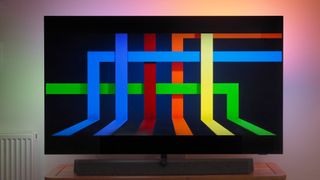

Specifications
Reasons to buy
Reasons to avoid
Philips has a couple of special tricks up its sleeve with the OLED 937: it's got built-in Ambilight, which projects real-time LED lighting onto surrounding surfaces, 'expanding' the pictures; and a Bowers & Wilkins built-in soundsystem, styled like a soundbar to the front of the TV, that sounds simply phenomenal.
Yes, it costs a pretty penny for the pleasure, but if you absolutely must have the best fully integrated TV on the market then, well, this is the OLED answer for you. Support for gaming is very reasonable, too, although really this is an out-and-out cinema enthusiast telly for those in the know.
Want the best picture and the best sound in one? You'll be wanting to read this full Philips OLED 937 review then, won't you?
Best for gamers
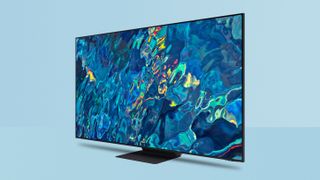

Specifications
Reasons to buy
Reasons to avoid
The Samsung 4K flagship from 2022 is an incredible thing, with its Neo QLED panel delivering almost searing levels of brightness, but packaged into a gorgeous, slim design that'll take pride of place in any room. This is a Quantum Dot Mini LED TV also manages to deliver black levels and colour reproduction to rival OLED though, which is massively appealing.
No, Samsung doesn't support Dolby Vision for its roster of HDR formats, but that's about the only real negative to be found here. If you're a gamer, in particular, then the separate One Connect box, with its four HDMI 2.1 ports, makes this the best TV for gamers – which is why it was the T3 Awards winner of both Best TV 2022 and Best Gaming TV 2022.
Note: there's also the Samsung QN95C, the 2023 model, which is also a 5-star product and even brighter – but as it's pricier the older model, and also does away with the One Connect box (a strange decision) the older model holds its position in this list.
Want an ultra-bright and gaming-focused TV? Check out our full Samsung QN95B review to learn more about this superb set
Best small screen
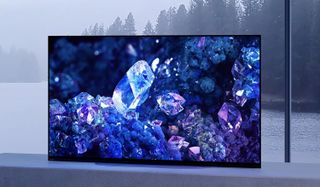

Specifications
Reasons to buy
Reasons to avoid
Not looking for a gigantic TV (and, let's face it, more and more are only available from 65-inches and up) then Sony's got a refreshing tonic for your consideration: the X90K only comes in 42-inch and 48-inch formats. Its target is clear: to deliver the best quality from a smaller TV panel. And oh boy does it deliver.
It's not 100 per cent on point though, as we said in our A90K review: "you have to get beyond both the asking price and the shortage of out-and-out brightness". But it acquits itself well: "when you do so, you’re left with a tiny OLED TV that’s capable of big image quality." It's also adept for gamers, thanks to four HDMI 2.1 ports, whereas most competitors only offer two with that spec.
If you're looking for a small-yet-premium 4K TV then read our full Sony A90K review to see if it's the winner for you
Best wall-mount


Specifications
Reasons to buy
Reasons to avoid
If you're looking to wall-mount a TV then this is the one destined for the job: LG's OLED G2 doesn't come with a stand-mount, it's strictly designed for the wall only. And once it's up there it'll look stunning thanks to a slender design and picture quality that's brighter than even its LG OLED C2 cousin.
That's the key takeaway with the G series model: it's LG's best panel each time around, ensuring an optimum OLED image without rival given the punch of brightness. You'll need to pay extra for that privilege of course, but for many that'll be worth it, so long as you can forego the presence of HDR10+ (which, given it's Dolby Vision capable, will be no bother to many).
Note: there's also the newer LG OLED G3, which is amazing even brighter still, making it the best OLED TV money can buy. But you need a lot of that mullah, which is why the older G2 model still holds strong in this best-of list.
Ready for wall-mounting an epic set? Read our full LG G2 review to see why this is the ideal telly for you
Best Sony OLED
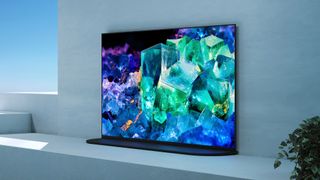

Specifications
Reasons to buy
Reasons to avoid
If money were no object then, in many ways, Sony's QD-OLED champion would beat Samsung's S95B option further up the page. The Sony sounds better for starters. Its pictures are more nuanced and believable too. But it doesn't half cost a lot.
Still, it'll be well worth it for some cinema fans. As we said in our review: "there's so much good to be gleaned from the Sony A95K", going on to praise its brighter-than-standard-OLED picture quality and making it "pretty much by default the best all-round 4K TV we’ve ever seen".
Note: there's a forthcoming A95L model, which is hugely bright, and that could be a contender replacement in the near future.
That enough to convince you? If not, read our full Sony A95K review to get the bigger picture on why this QD-OLED TV is so impressive
Best Ambilight
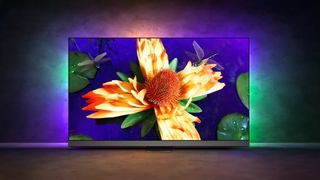

Specifications
Reasons to buy
Reasons to avoid
Philips' OLED TVs never fail to impress thanks to Ambilight, whereby the picture is 'projected' in real-time beyond the TV's frame. And while its sound isn't as dramatic as its Philips 937 cousin, we think this sounds better than many of its competitors, which is when its asking price begins to seem all the more reasonable for those of us who don't wish to disturb our neighbours.
As said in our Philips 907 review: "It doesn’t look any kind of bargain on paper, but once you realise there’s no need for further spending on a soundbar the Philips OLED 907 starts to seem better value. Then you see the picture quality of which it’s capable, and add in the unique effect of its three-sided Ambilight, and the price suddenly seems absolutely fair enough. This is a TV superstar."
If you're looking for Ambilight is this the OLED TV for you? Read our full Philips OLED 907 review to get the fuller picture
Best Dolby Atmos
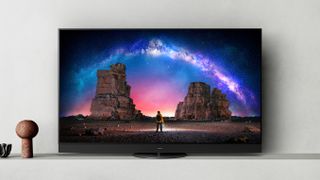

Specifications
Reasons to buy
Reasons to avoid
While Philips does a great job of delivering convincing sound from its TVs, it's Panasonic that takes the crown for delivering the most convincing Dolby Atmos surround sound straight out of the box. That's thanks to the LZ2000's huge soundsystem that's positioned all around the rear of the panel, ensuring upfiring coverage that no other TV can compete with, not unless there's a proper surround system mated with it anyway.
Add to this Panasonic's superb handling of images, its full-house when it comes to HDR format compatibility, and OLED quality that simply rivals the best of them, and this is an epic all-round telly. It's often very fairly priced, too, which may give it a further leg up compared to its most obvious Philips rivals.
Note: there's an MZ2000 replacement model on the way, which hugely impressed on its reveal at CES 2023, so another great-sounding option for the future.
Want an all-in-one TV-and-soundsystem without the need for extras? Read our full Panasonic LZ2000 review to see if this is the TV best suited for you
Best 8K TV
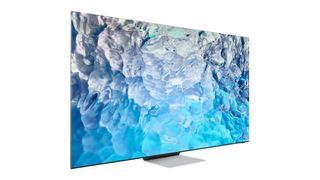

Specifications
Reasons to buy
Reasons to avoid
Mini-LED is making waves, and the Samsung QN900B – with its Neo QLED panel – is hanging ten on those waves and looking damn cool while doing it. It's a totally stunning 8K TV, a true flagship in every sense, with incredible picture quality, great connectivity, and black levels that rival anything in the OLED space.
We've reviewed the 75-inch model, where we noted that its high dynamic range (HDR) performance is really class-leading stuff, its 4K upscaling is totally convincing, the maximum brightness far exceeds OLED (hitting 4,000 nits), and contrast is remarkable. The QN900B really is the complete package, plus it's ready for next-gen high-frame-rate gaming too.
Note: the newer QN900C model is now available since 2023, which is another 5-star option, but the extra cost may make the 'B' model even more appealing.
If you want to read more about the best 8K TV on the market at the moment, then head to our Samsung QN900B review for the full rundown.
How to choose
Shortlisting your next television can be a complicated business, but a few simple rules of thumb will help.
As we move from HD to 4K and ultimately 8K, screen size becomes a key consideration. To see incremental differences in resolution, you’ll probably need to buy a bigger screen than you had previously, or move your seating closer. Long story short: think big, then buy bigger.
Counter intuitive it may well be, but ultra-large 8K screens are perfect for smaller rooms, if you want to really see every drop of detail. Everything you think you know about viewing distances is changing…
Then there’s viewing environment. If you tend to watch in high ambient lighting, or during daytime, an LED or QLED screen will typically serve you better than OLED. If you prefer to watch with low or no lighting, an OLED will deliver greater subjective contrast and shadow detail.
Smart platforms are no longer a decisive reason to buy. All TVs are smart these days, and the choice of apps ubiquitous – focus on image quality, price and any other features you're keen on.
What is a 4K TV?
4K refers to the resolution of the TV (ie, how many pixels it has), and is exactly the same as Ultra HD when it comes to TVs. It means the set has a resolution of 3840x2160 – for comparison, that's four times the number of pixels as Full HD sets offer. These days, practically every TV above 40 inches is 4K.
The higher resolution means a far more detailed picture. Not everything you watch is available in 4K, though, so 4K TVs tend to be good at upscaling HD video to Ultra HD – the sets are full of advanced processors and algorithms that can fill in the missing pixels in a really convincing way.
You will also see that 8K TVs are available now – this quadruples the resolution again to 7680x4320. The best 8K TVs are very premium purchases, though, and are only worth considering if you're planning to get a really large TV, otherwise you can't really make out the extra pixels anyway.
What types of TV display can I choose from?
OLED TV
The lighting on OLED (organic light emitting diode) TVs is achieved by passing an electric current through an emissive, electroluminescent film. This technique produces beautiful colour and high contrast and also enables screens to be extremely thin and flexible. LG Display is the only supplier of 4K OLED screens to mainstream TV manufacturers, meaning they all use the same panels, but picture processors and implementation all vary, so you can still expect differences between brands.
Quantum Dot/QLED
Samsung is the leading exponent of QLED, a variant of LED LCD display technology that uses a highly efficient Quantum Dot filter that increases brightness and colour volume. QLED screens with a full array backlight offer the best performance when it comes to HDR peak brightness and LCD black level control.
LED TV: Direct LED
Sometimes called FALD (Full Array Local Dimming), these displays are backlit by an array of LEDs (light emitting diodes) directly behind the screen. This enables localised dimming – meaning immediately adjacent areas of brightness and darkness can be displayed more effectively – and greatly improves contrast.
LED TV: Edge LED
With these Edge LED TVs, the LEDs of the backlight are mounted along the edges of the panel. This arrangement enables radically slender displays, but can't achieve the same picture quality as directly lit LED sets. However, Edge LED displays do come in far cheaper, which is why the more budget LED TVs out there use this technology.
What is a smart TV?
This just means that the TV has its own software built-in and the ability to connect to the internet, meaning that you can access streaming services such as Netflix, Amazon Prime Video, Disney+ and so on.
Some manufacturers use their own software that they design: Samsung and LG, for example. Other makers use software made by another company, such as Sony TVs using Google TV software, or TVs from many manufacturers using the Roku TV software.
Today, basically any TV is a smart TV, so you don't need to worry too much about trying to find a particularly smart one.
What should I look for when buying a TV?
Here are some of the things we look for when we review a TV screen, so you should, too...
Contrast: Bright whites shouldn't have any signs of green, pink or blue in them, while blacks should look solid and not washed out, grey, green or blue.
Colours: Look at how bright and solid they are; how noiseless their edges are; how 'dotty' richly saturated areas are and how natural skin looks, especially in dim scenes.
Fine detail: How much texture does the screen give? Does a tree look like a green lump, or can you see the individual leaves?
Edges: Check for ghosting, bright halos and jaggedness, especially around curves.
Motion: Check moving objects and quick camera pans for smearing or blurring, trailing, jerkiness and fizzing dotty noise.
Image artefacts: Look for blockiness, colour bands, grain, smearing, dot crawl: anything that looks like it's added by the TV’s picture processing engine.
What about TV sound?
To provide the best audio to complement the pictures, your TV should be hooked up to a separate audio system, be it soundbar or home cinema separates, but this isn't always an option. So, here's what we listen for when testing a TV's speakers:
Bass: Deep, rounded rumbles that don't cause the set to rattle or speakers to distort cramp or overwhelm the rest of the sound; but that expand when needed.
Vocals: Voices should sound open, rich and clear, not boxed in, nasal or thin.
Trebles: Treble effects should sound clean, rounded and smooth in loud scenes and shouldn't dominate the soundstage.
Soundstage width/depth: A good TV should throw the sound away from the TV, to the sides, forward and back, to give an extra dimension to what's on screen, without losing any coherence.
How we test
As said in T3's extensive How We Test page: our TV testing can "only be achieved by truly living with a product". That's paramount for testing our TVs, in order to be at one with the way they function, react to changing lighting conditions, or different modes. We'll find high points and any quirks that mark these sets down.
In addition, however, it's key to also measure TVs using tools so we can gauge whether their brightness delivers as potently as is claimed. That way we know what the brightest and most dynamic sets are. And, of course, there are all manner of features – as outlined in the sections above – to take on board, from the panel technology and backlight, to the high dynamic range compatibility, and the sound quality.
Once we've pulled together all our testing and real-world living, we're then able to contextualise how a TV fits into the broader market and award it a score, with the lucrative T3 5-star badge the ultimate accolade awarded to only the very best tellies available.
Reviewer Panel

It's part of my job here at T3 to test the best TVs, so I'm often hosting a brand new set in my living room, treating it as if it's my own, to gauge how impressive its sound, picture quality and features are. It's this first-hand experience and knowledge that inputs into this best TV guide.
Sign up to the T3 newsletter for smarter living straight to your inbox
Get all the latest news, reviews, deals and buying guides on gorgeous tech, home and active products from the T3 experts

Mike is T3's Tech Editor. He's been writing about consumer technology for 15 years and his beat covers phones – of which he's seen hundreds of handsets over the years – laptops, gaming, TV & audio, and more. There's little consumer tech he's not had a hand at trying, and with extensive commissioning and editing experience, he knows the industry inside out. As the former Reviews Editor at Pocket-lint for 10 years where he furthered his knowledge and expertise, whilst writing about literally thousands of products, he's also provided work for publications such as Wired, The Guardian, Metro, and more.
-
 Motorola Razr 60 Ultra shown in leaked promo material, looks like a Z Flip beater
Motorola Razr 60 Ultra shown in leaked promo material, looks like a Z Flip beaterAnd it's running flagship hardware too
By Britta O'Boyle Published
-
 In an age of exciting upgrades, Google could downgrade the Pixel 10 instead
In an age of exciting upgrades, Google could downgrade the Pixel 10 insteadThere’s a change coming to the Pixel cameras and it could cause a stir
By Chris Hall Published
